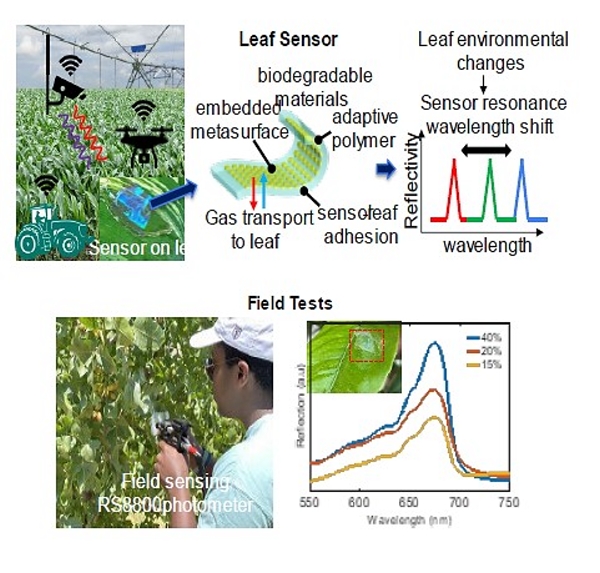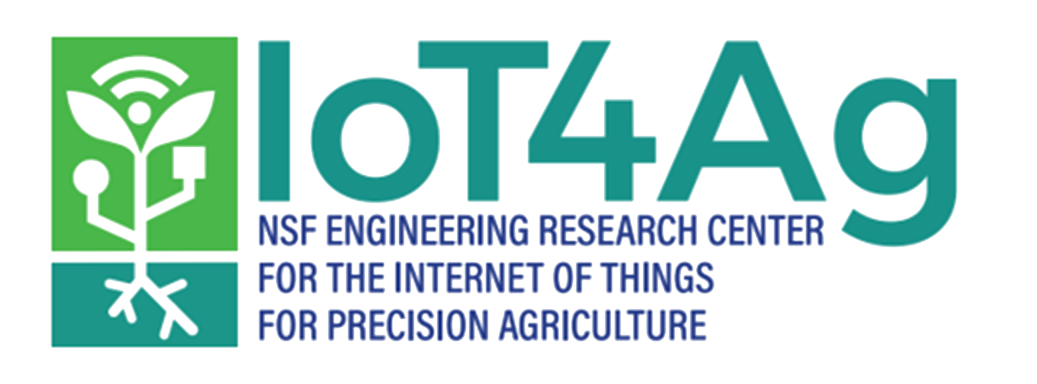New Sensors Help Farmers, Food Security, and the Environment
Outcome/Accomplishment
Drought is a leading cause of crop stress and the resulting economic injury to farmers. LEAFSENSE is a sophisticated sensor technology that researchers are developing to help farmers actively monitor leaf moisture and temperature levels, allowing them to be proactive and make informed decisions in crop cultivation before yields are permanently affected. The research continues to yield positive results, advancing the technology toward commercial use. This important work is supported by the U.S. National Science Foundation (NSF)-funded Internet of Things for Precision Agriculture (IoT4Ag) Engineering Research Center (ERC) headquartered at the University of Pennsylvania (Penn).
Impact/Benefits
The Internet of Things (IoT) encompasses physical objects with sensors, processing ability, software, and other technologies that connect and exchange data with other devices and systems over the Internet or other communications networks. IoT4Ag is working to enable IoT technologies for precision agriculture that will address the challenges of assuring food, energy, and water security for decades to come. LEAFSENSE combines artificial intelligence and smart sensors to enable precision agriculture, optimizing productivity and reducing costs while minimizing the use of energy and water resources and the impact of agricultural practices on the environment. The sensors are cost-effective compared to current moisture sensors, do not require power, and are biodegradable and biocompatible, so they do not need to be retrieved from the field. Researchers are finding that the sensors can be designed to measure multiple parameters and can be extended to other applications, including manufacturing.
Explanation/Background
By 2050, the US population is estimated to grow to 400 million and the world population to 9.7 billion. With finite arable land, water, and energy resources, ensuring food, energy, and water security will require new technologies to improve the efficiency of food production, create sustainable approaches to supply energy, and prevent water scarcity.
The LEAFSENSE research team developed the biodegradable, adhesive, colorimetric sensors using moisture-sensitive Chitosan polymer, as well as a single-step, low-cost, scalable, and sustainable fabrication process using a custom-built nanoimprint tool and solution-processable nanocrystal inks. Field tests were successfully conducted on pistachio, almond, and citrus crop leaves in testbed orchards, enabling the team to characterize their adhesive properties and color shifts. Their work led to publication of a scientific paper and a provisional patent application.
Location
Philadelphia, Pennsylvaniawebsite
Start Year
Microelectronics and IT
Microelectronics, Sensing, and IT
Lead Institution
Core Partners
Fact Sheet
Outcome/Accomplishment
Drought is a leading cause of crop stress and the resulting economic injury to farmers. LEAFSENSE is a sophisticated sensor technology that researchers are developing to help farmers actively monitor leaf moisture and temperature levels, allowing them to be proactive and make informed decisions in crop cultivation before yields are permanently affected. The research continues to yield positive results, advancing the technology toward commercial use. This important work is supported by the U.S. National Science Foundation (NSF)-funded Internet of Things for Precision Agriculture (IoT4Ag) Engineering Research Center (ERC) headquartered at the University of Pennsylvania (Penn).
Location
Philadelphia, Pennsylvaniawebsite
Start Year
Microelectronics and IT
Microelectronics, Sensing, and IT
Lead Institution
Core Partners
Fact Sheet
Impact/benefits
The Internet of Things (IoT) encompasses physical objects with sensors, processing ability, software, and other technologies that connect and exchange data with other devices and systems over the Internet or other communications networks. IoT4Ag is working to enable IoT technologies for precision agriculture that will address the challenges of assuring food, energy, and water security for decades to come. LEAFSENSE combines artificial intelligence and smart sensors to enable precision agriculture, optimizing productivity and reducing costs while minimizing the use of energy and water resources and the impact of agricultural practices on the environment. The sensors are cost-effective compared to current moisture sensors, do not require power, and are biodegradable and biocompatible, so they do not need to be retrieved from the field. Researchers are finding that the sensors can be designed to measure multiple parameters and can be extended to other applications, including manufacturing.
Explanation/Background
By 2050, the US population is estimated to grow to 400 million and the world population to 9.7 billion. With finite arable land, water, and energy resources, ensuring food, energy, and water security will require new technologies to improve the efficiency of food production, create sustainable approaches to supply energy, and prevent water scarcity.
The LEAFSENSE research team developed the biodegradable, adhesive, colorimetric sensors using moisture-sensitive Chitosan polymer, as well as a single-step, low-cost, scalable, and sustainable fabrication process using a custom-built nanoimprint tool and solution-processable nanocrystal inks. Field tests were successfully conducted on pistachio, almond, and citrus crop leaves in testbed orchards, enabling the team to characterize their adhesive properties and color shifts. Their work led to publication of a scientific paper and a provisional patent application.

